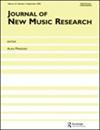Automatic subgenre classification in an electronic dance music taxonomy
IF 0.9
4区 计算机科学
Q4 COMPUTER SCIENCE, INTERDISCIPLINARY APPLICATIONS
引用次数: 9
Abstract
Electronic dance music (EDM) is a genre where thousands of new songs are released every week. The list of EDM subgenres considered is long, but it also evolves according to trends and musical tastes. With this in view, we have retrieved two sets of over 2000 songs separated by more than a year. Songs belong to the top 100 list of an EDM website taxonomy of more than 20 subgenres that changed in the period considered. We test the effectiveness of automatic classification on these sets and delve into the results to determine, for example, which subgenres perform better and worse, how the performance of some subgenres change in the two sets, or how some subgenres are often confused with one another. We illustrate confusion among subgenres by a graph and interpret it as a taxonomic map of EDM. We also assess the deterioration of the performance of the classifier of the first set when used to classify the second one. Finally, we study how the new subgenres that appear in the second set relate to the old ones with the help of the classifier of the first set. As a result, this work illustrates the main challenges that EDM poses to automatic classification and provides insights into where are the limits of this approach.电子舞曲分类学中的自动子类型分类
电子舞曲(EDM)是一种每周都会发布数千首新歌的音乐类型。考虑的EDM子类型列表很长,但它也会根据趋势和音乐品味而发展。鉴于此,我们检索了两套2000多首歌曲,间隔一年多。在一个EDM网站的分类中,歌曲属于前100名,该分类中有20多个子类型在研究期间发生了变化。我们在这些集合上测试自动分类的有效性,并深入研究结果,以确定哪些子类型表现得更好,哪些更差,某些子类型在两个集合中的表现如何变化,或者某些子类型如何经常相互混淆。我们用一个图来说明各子流派之间的混淆,并将其解释为EDM的分类图。我们还评估了第一组分类器在分类第二组时性能的恶化。最后,我们在第一集分类器的帮助下,研究了第二集中出现的新子类型与旧子类型的关系。因此,这项工作说明了EDM对自动分类提出的主要挑战,并提供了对这种方法的局限性的见解。
本文章由计算机程序翻译,如有差异,请以英文原文为准。
求助全文
约1分钟内获得全文
求助全文
来源期刊

Journal of New Music Research
工程技术-计算机:跨学科应用
CiteScore
3.20
自引率
0.00%
发文量
5
审稿时长
>12 weeks
期刊介绍:
The Journal of New Music Research (JNMR) publishes material which increases our understanding of music and musical processes by systematic, scientific and technological means. Research published in the journal is innovative, empirically grounded and often, but not exclusively, uses quantitative methods. Articles are both musically relevant and scientifically rigorous, giving full technical details. No bounds are placed on the music or musical behaviours at issue: popular music, music of diverse cultures and the canon of western classical music are all within the Journal’s scope. Articles deal with theory, analysis, composition, performance, uses of music, instruments and other music technologies. The Journal was founded in 1972 with the original title Interface to reflect its interdisciplinary nature, drawing on musicology (including music theory), computer science, psychology, acoustics, philosophy, and other disciplines.
 求助内容:
求助内容: 应助结果提醒方式:
应助结果提醒方式:


